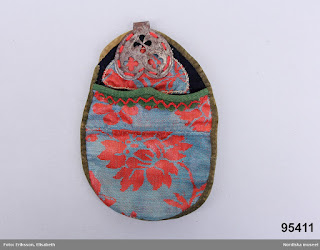That's me at the K90-ski jumping hill in Örnsköldsvik where I spent Saturday as a distance measurer and Sunday as a jumping judge, next weekend I'm organizing the 90th anniversary for the ski jumping club in Falun, and the weekend after that I'm off to Stockholm to judge a ski jumping competition there.
But back to sewing, and finding a small project that fits the challenge. The challenge is "sewing secrets" - hide something in your sewing, whether it is an almost invisible mend, a secret pocket, a false fastening or front, or a concealed message (such as a political or moral allegiance).
My plan is to make an 18th century pocket. The one I have is a nice one that I've embroidered. When I use it I'm a bit worried that it won't hold up for a totally incorrect phone, or that the embroidery will fray. I want a pocket that's a bit more plain, but also sturdier. Pockets were supposed to be worn under your clothes, so in that way they are secret, but I'm hoping to add something more that won't be obvious even for the people that I might show the pocket to, a proper sewing secret.
With that in mind I dived into Digitalt Museum - which is a great database of digitzed collections from Swedish museums. Of course that means that you have to search in Swedish, and there is no really set terminology, it's just what happened to be written either by the person who collected the object into the collection, or the person putting it up in the database.
A lot of the pockets that have been saved are fancy with beautiful applications, but there are a couple of ones that I feel are closer to what I would like.
 |
| Foto: Eriksson, Elisabeth / Nordiska museet |
 |
| Eriksson, Elisabeth / Nordiska museet |
The third pocket is from Värmland, and as you can see it's rectangular and not rounded like the other two. This pocket is made out of leather, but what I like about it is the letters, they are probably the initials of the owner, and date.
With that in mind my general idea is to make a pocket out of some scraps that I have. There is a craft café next Monday, and since my other major projects is all about machine sewing this could be a nice thing to work with.



No comments:
Post a Comment